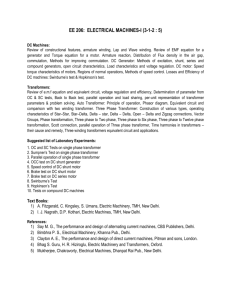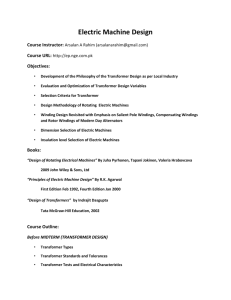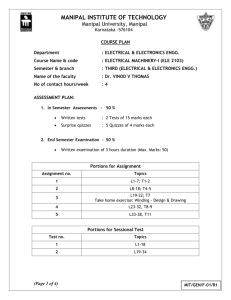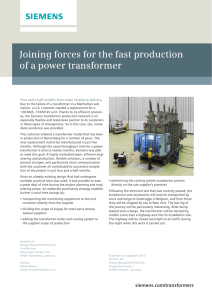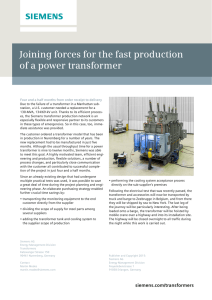Predictive maintenance and modeling of Transformer
advertisement
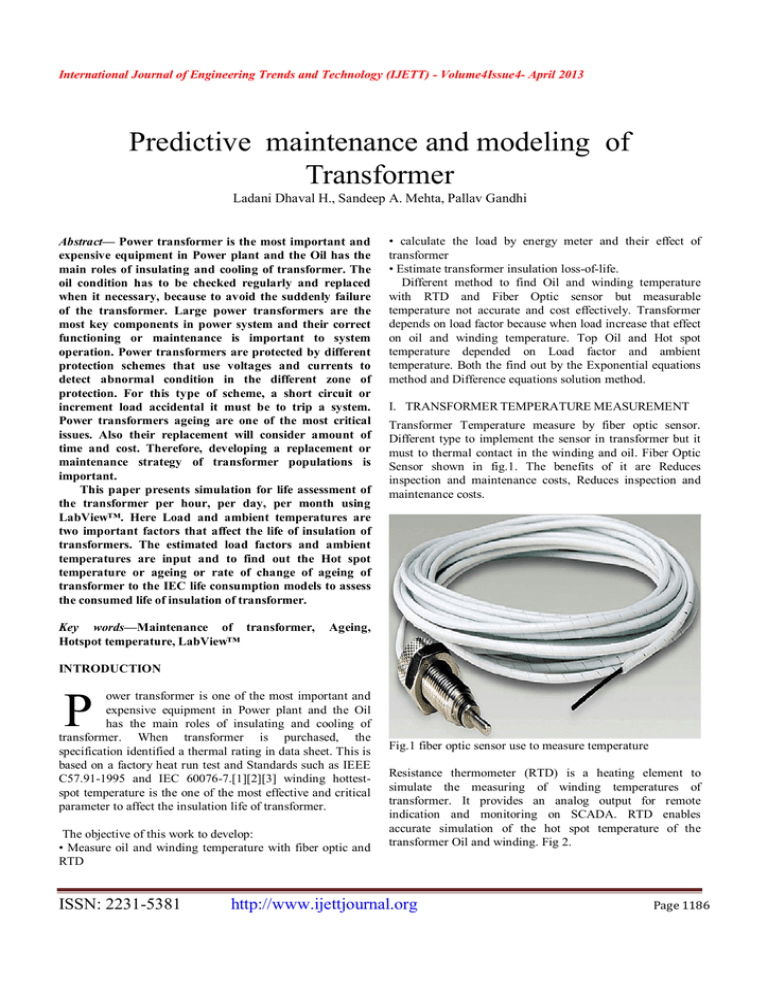
International Journal of Engineering Trends and Technology (IJETT) - Volume4Issue4- April 2013 Predictive maintenance and modeling of Transformer Ladani Dhaval H., Sandeep A. Mehta, Pallav Gandhi Abstract— Power transformer is the most important and expensive equipment in Power plant and the Oil has the main roles of insulating and cooling of transformer. The oil condition has to be checked regularly and replaced when it necessary, because to avoid the suddenly failure of the transformer. Large power transformers are the most key components in power system and their correct functioning or maintenance is important to system operation. Power transformers are protected by different protection schemes that use voltages and currents to detect abnormal condition in the different zone of protection. For this type of scheme, a short circuit or increment load accidental it must be to trip a system. Power transformers ageing are one of the most critical issues. Also their replacement will consider amount of time and cost. Therefore, developing a replacement or maintenance strategy of transformer populations is important. This paper presents simulation for life assessment of the transformer per hour, per day, per month using LabView™. Here Load and ambient temperatures are two important factors that affect the life of insulation of transformers. The estimated load factors and ambient temperatures are input and to find out the Hot spot temperature or ageing or rate of change of ageing of transformer to the IEC life consumption models to assess the consumed life of insulation of transformer. Key words—Maintenance of transformer, Hotspot temperature, LabView™ • calculate the load by energy meter and their effect of transformer • Estimate transformer insulation loss-of-life. Different method to find Oil and winding temperature with RTD and Fiber Optic sensor but measurable temperature not accurate and cost effectively. Transformer depends on load factor because when load increase that effect on oil and winding temperature. Top Oil and Hot spot temperature depended on Load factor and ambient temperature. Both the find out by the Exponential equations method and Difference equations solution method. I. TRANSFORMER TEMPERATURE MEASUREMENT Transformer Temperature measure by fiber optic sensor. Different type to implement the sensor in transformer but it must to thermal contact in the winding and oil. Fiber Optic Sensor shown in fig.1. The benefits of it are Reduces inspection and maintenance costs, Reduces inspection and maintenance costs. Ageing, INTRODUCTION ower transformer is one of the most important and expensive equipment in Power plant and the Oil has the main roles of insulating and cooling of transformer. When transformer is purchased, the specification identified a thermal rating in data sheet. This is based on a factory heat run test and Standards such as IEEE C57.91-1995 and IEC 60076-7.[1][2][3] winding hottestspot temperature is the one of the most effective and critical parameter to affect the insulation life of transformer. P The objective of this work to develop: • Measure oil and winding temperature with fiber optic and RTD ISSN: 2231-5381 Fig.1 fiber optic sensor use to measure temperature Resistance thermometer (RTD) is a heating element to simulate the measuring of winding temperatures of transformer. It provides an analog output for remote indication and monitoring on SCADA. RTD enables accurate simulation of the hot spot temperature of the transformer Oil and winding. Fig 2. http://www.ijettjournal.org Page 1186 International Journal of Engineering Trends and Technology (IJETT) - Volume4Issue4- April 2013 When measuring oil and winding temperature by sensor their output to calculate the hot spot temperature and loss of life per hour, per day and monitoring with SCADA. All calculation follows by IEEE [1] and IEC [3] their simulation in LabView™. 3) Find winding hottest spot temperature t H ( H ,U H , i ) 1 e w H ,i Where, H winding hottest - spot rise over top oil temperatu re C = ultimate winding Temperatur e C H, U H = Initial winding Temperatur e for t 0, C w = Winding time constant at hot spot , h III. DIFFERENTIAL EQUATION SOLUTION METHOD WITH LOADING Fig.2 RTD use to measure temperature This describes to use of heat transfer differential equations, applicable for randomly time-varying load factor K and time-varying ambient temperature θ a. They are intended to be the basis for the software to process data in order to define hot-spot temperature as a function of time and consequently the corresponding insulation life consumption. The differential equations are represented in block diagram form in Fig 3. Observe in Fig 3 that the inputs are the load factor K, and the ambient temperature θ a. The output is the desired hot-spot temperature θ h on the right. II. CALCULATE HOT SPOT TEMPERATURE WITHOUT LOADING EFFECT The purpose of this calculation to know the transformer life and save the replacement coast. 1) Find hottest spot temperature H A TO H Where, winding hottest - spot tempe rature C H A = Average Ambient Temperatur e C TO = Top oil rise over ambient Temperatur e C H = Winding hottest spot tempe rature C 2) Find Top oil temperature TO A TO Where, winding hottest - spot tempe rature C H A = Average Ambient Temperatur e C Fig. 3 differential equation block diagram (1) Find Top oil at load Dt D 0 K 11 0 0 n x 1 K 2 R or 0 a 1 R 0 n 1 D Where, = Top oil rise over ambient Temperatur e C TO = Winding hottest spot tempe rature H ISSN: 2231-5381 http://www.ijettjournal.org Page 1187 0 n International Journal of Engineering Trends and Technology (IJETT) - Volume4Issue4- April 2013 Top oil temperatu re at load C 0 = Ambient Temperatur e C a N or = Top oil rise over at rated losses Temperatur e C K = Load factor R ratio of load losses at rated current to no load losses F EQA F AA tn n 1 N tn n 1 x exponentia l power of total losses versus top oil temp. rise 0 Where, = Oil time constant, F AA Ageing Accelerati on Factor F Equivalent Ageing Factor for total time EQA (2) Find Hot-Spot temperature Dt D h1 K 21 hr K K 22 w y h1 % LossofLife h1 n h1 n 1 Dh1 n D h2 Dt 1 w K 22 K 1 K 21 hr FEQA t 100 NormalInsu lationLife Where, F Equivalent Ageing Factor for total time EQA y h2 h 2 n h 2 n 1 D h 2 n h n h1 n h 2 n H n 0 n h n Where, Top oil temperatu re rise at load K 0 Normalinsu lationlife 180000 PerUnitLif e 9.8 10 18 e 15000 H 273 Where, H = Hot Spot Temperatur e, IV. SIMULATION IN LEBVIEW™ SOFTWARE K K = Thermal model constant 11 21 22 = Hot Spot to top oil gradient at rated current, K hr K y exponentia l power of total losses versus top winding temp. rise w = winding time constant, H = Hot Spot Temperatur e, (3)Loss of Life of Transformer F AA e 15000 383 15000 H 273 Where, FIG.4 AGE FACTOR AT 110 C TEMPERATURE Ageing Accelerati on Factor AA H = Hot Spot Temperatur e, By implementing above input values in mathematical formulas simulate in LabView and get the results as below. F ISSN: 2231-5381 http://www.ijettjournal.org Page 1188 International Journal of Engineering Trends and Technology (IJETT) - Volume4Issue4- April 2013 TABLE I. Temperature 110 120 130 140 150 OUTPUT DATA Age Factor 0.35 1 2.71 6.98 17.2 Percent Loss Life 0.0133 0.0133 0.0133 0.0133 0.0133 Hours 24 8.86 7 1.4 1 There are so many parameters which affect the transformer ageing. This paper contains the effects of only two parameters which are Ambient Temperature and Load factor. So by changing the parameters one by one we get the variations in output parameters which are shown in the below tables. Table2: Changing the Load factor and ambient temperature Ambient Temp. 30.3 Load factor 0.81 Hot spot Temp. 90.5 Loss of Life Per day 0 29.9 0.87 91.6 0 28.6 1 101.6 0 28.0 1.7 118.7 0.01 22.3 0.82 124.1 6.15 22.2 0.86 123.7 6.15 V. CONCLUSION From above tests and results we can tell when the Load of the transformer and Ambient temperature of transformer is the minimum that will give the more Life of Transformer. When load increase then life decreases. This understanding helps to maintenance of transformer without failure. VI. REFERENCES [1] IEEE Guide for Loading Mineral-Oil-Immersed Transformers Up to and Including 100 MVA With 55 C or 65 C Average Winding Rise, IEEE Stand. C57.92-1981. [2] IEEE Guide for Loading Mineral-Oil-Immersed Overhead and Pad-Mounted Distribution Transformers Rated 500 kVA and Less With 65 C or 55 C Winding Rise, IEEE Stand. C57.91-1981. [3] IEC 60076-7 Part 7: 'Loading Guide for Oilimmersed Power Transformers', 2005. [4] IEEE Guide for Loading Mineral-Oil-Immersed Transformers, IEEE Stand. C57.91-1995. ISSN: 2231-5381 http://www.ijettjournal.org Page 1189
